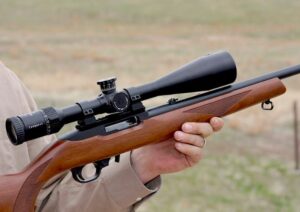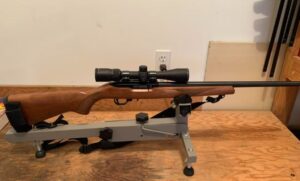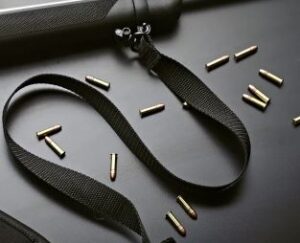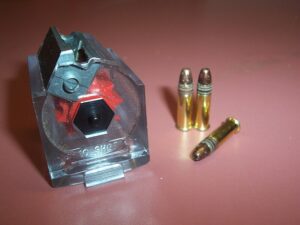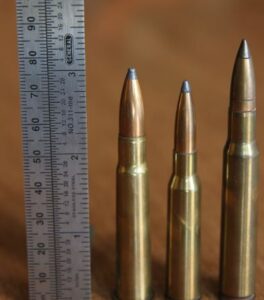
Choosing the perfect scope for your Ruger 1022 rifle is a crucial decision that can significantly impact your shooting accuracy and overall experience. Whether you’re a seasoned marksman or a beginner looking to upgrade your setup, understanding the key factors to consider when selecting a 1022 scope is essential for achieving consistent, reliable performance.
| Key Factors | Considerations |
|---|---|
| Magnification | The right magnification range can provide the optimal balance between target acquisition and field of view. |
| Objective Lens Size | Larger objective lenses typically offer better light transmission and image clarity, especially in low-light conditions. |
| Reticle Type | Different reticle designs cater to various shooting applications, from simple crosshairs to more complex mil-dot or BDC (Bullet Drop Compensation) patterns. |
Navigating the vast array of scope options can be daunting, but by understanding these key factors and how they relate to your specific needs, you can make an informed decision that will enhance your 1022 rifle’s performance and your overall shooting experience.
What is a Rifle Scope?
A rifle scope, also known as a telescopic sight, is an optical device that mounts on the top of a rifle to provide magnified, precise aiming. It consists of a series of lenses and reticles (crosshairs or other aiming points) that allow the shooter to accurately identify and engage targets at various distances. Rifle scopes are essential accessories for many types of firearms, including the popular Ruger 1022 rimfire rifle, as they enable shooters to take more accurate shots and extend the effective range of their weapons.
Factors to Consider When Selecting a 1022 Scope
When choosing a scope for your 1022 rifle, there are several crucial factors to consider to ensure you select the best option for your needs and preferences. These include:
Magnification: The magnification range of the scope is a critical consideration, as it determines how much the target will appear to be enlarged. For the 1022 rifle, a magnification range of 3-9x or 4-12x is often a versatile and popular choice, providing enough zoom to engage targets at medium ranges while still maintaining a relatively wide field of view.
Objective Lens Size: The objective lens is the front lens of the scope, and its size directly impacts the amount of light that can enter the optical system. Larger objective lenses, such as 40mm or 50mm, generally provide better light transmission and image clarity, especially in low-light conditions.
Reticle Type: The reticle, or aiming point, comes in various designs, each with its own advantages. Common reticle types for the 1022 rifle include the classic duplex, mil-dot, and BDC (Bullet Drop Compensation) reticles, each offering different features and capabilities for range estimation, holdover, and windage adjustments.
Magnification Ranges for the 1022 Rifle
The ideal magnification range for a Ruger 1022 rifle scope will depend on the intended use and shooting distances. For general plinking, target shooting, and small game hunting at relatively close ranges, a magnification range of 3-9x or 4-12x is often considered the sweet spot. This provides enough zoom to accurately engage targets at medium distances while still maintaining a reasonably wide field of view for easy target acquisition.
Lower magnification scopes, such as 2-7x or 3-9x, are well-suited for close-range applications, where a wider field of view can be advantageous for quick target acquisition and tracking. Higher magnification scopes, in the 6-24x or 8-32x range, are more appropriate for longer-range precision shooting, allowing for more detailed target identification and holdover adjustments at extended distances.
Ultimately, the magnification range you choose should be based on your specific shooting needs and the typical engagement distances you anticipate encountering with your 1022 rifle.
Objective Lens Size and Light Transmission
The objective lens size of a rifle scope is an important factor that directly impacts the amount of light that can enter the optical system and reach your eye. Larger objective lenses, such as 40mm or 50mm, generally provide better light transmission and image clarity, especially in low-light conditions like early morning or late evening.
This improved light transmission can be particularly beneficial for the 1022 rifle, which is often used for plinking, target shooting, and small game hunting in a variety of lighting environments. A larger objective lens allows more light to reach the shooter’s eye, resulting in a brighter, clearer image and improved target visibility.
However, it’s important to note that larger objective lenses also typically result in a heavier and bulkier scope, which may not be ideal for all 1022 rifle applications or personal preferences. As such, finding the right balance between objective lens size, weight, and overall scope dimensions is crucial when selecting the perfect scope for your 1022 rifle.
Reticle Types and Their Applications
The reticle, or aiming point, of a rifle scope is a critical component that can significantly impact the shooter’s ability to accurately engage targets. Various reticle designs are available, each with its own unique features and benefits:
Duplex Reticle: The classic duplex reticle features simple crosshairs, providing a clean, unobstructed sight picture. This design is well-suited for general plinking, target shooting, and small game hunting at medium ranges with the 1022 rifle.
Mil-Dot Reticle: The mil-dot reticle incorporates a series of dots along the vertical and horizontal crosshairs, allowing the shooter to estimate the range to the target and make accurate holdover adjustments for windage and elevation. This reticle is popular for long-range precision shooting with the 1022 rifle.
BDC (Bullet Drop Compensation) Reticle: The BDC reticle features multiple aiming points or hash marks along the vertical crosshair, corresponding to the trajectory of the specific ammunition being used. This reticle design simplifies the process of compensating for bullet drop at longer ranges, making it a valuable choice for 1022 rifle enthusiasts who engage targets at varying distances.
When selecting a reticle type for your 1022 rifle, consider the specific shooting scenarios and distances you anticipate encountering, as well as your personal preferences and shooting style.
Durability and Weatherproofing for the 1022
When choosing a scope for your 1022 rifle, it’s essential to consider the durability and weatherproofing of the optic. The 1022 is a reliable and rugged rifle, and you’ll want a scope that can withstand the same level of use and environmental conditions.
Look for scopes that are shockproof, waterproof, and fog-proof, ensuring that your investment can withstand the rigors of outdoor use, including recoil, precipitation, and temperature changes. Many high-quality rifle scopes are nitrogen-purged and o-ring sealed, providing reliable protection against the elements.
Additionally, consider the construction materials of the scope, such as aircraft-grade aluminum or other durable alloys, which can enhance the overall ruggedness and longevity of the optic. This is particularly important for the 1022 rifle, which is often used in a variety of settings, from the shooting range to the hunting field.
By selecting a durable, weatherproof scope, you can ensure that your 1022 rifle setup remains reliable and accurate, even in challenging environmental conditions.
Adjusting the Scope for Optimal Accuracy
Properly adjusting and sighting in your 1022 rifle scope is crucial for achieving optimal accuracy and consistent performance. This process typically involves the following steps:
Mounting the Scope: Ensure the scope is securely and correctly mounted on your 1022 rifle, following the manufacturer’s instructions to maintain proper alignment and eye relief.
Bore Sighting: Bore sighting, or aligning the scope’s reticle with the rifle’s bore, is an essential first step to get your point of aim and point of impact closer together before live-fire testing.
Test Firing and Adjustments: Once the scope is mounted, take your 1022 rifle to the range and test fire at a known distance, typically 25 or 50 yards. Adjust the elevation and windage knobs on the scope to center the point of impact on your target, ensuring your reticle and point of impact are aligned.

Refining the Zero: After the initial adjustments, continue test firing at various distances to fine-tune the scope’s zero, making further elevation and windage adjustments as needed to achieve a consistent, accurate point of impact.
By meticulously adjusting and sighting in your 1022 rifle scope, you’ll be able to maximize the potential of your rifle and enjoy reliable, precise performance, whether you’re target shooting, plinking, or hunting small game.
Mounting the Scope Properly on Your 1022
Properly mounting the scope on your Ruger 1022 rifle is crucial for ensuring accurate and consistent performance. This process involves several key steps:
Scope Ring Selection: Choose the appropriate scope rings or mounts that are compatible with your 1022 rifle and the specific scope you’ve selected. Ensure the rings provide a secure, level fit on the rifle’s receiver.
Alignment and Positioning: Position the scope on the rifle’s receiver, aligning it with the bore axis and maintaining the recommended eye relief distance. This will help prevent the scope from interfering with the cycling of the action.
Tightening and Torquing: Carefully tighten the scope rings or mounts, applying the recommended torque values to prevent the scope from shifting or loosening during use. Use a torque wrench for precise, even tightening.
Bore Sighting: Once the scope is mounted, perform a bore sighting procedure to roughly align the reticle with the rifle’s bore, setting the stage for further fine-tuning at the range.
By properly mounting and securing the scope on your 1022 rifle, you’ll ensure the optic remains stable and aligned, allowing you to take full advantage of its precision and accuracy capabilities.
Sighting in the Scope for Consistent Shots
Sighting in your 1022 rifle scope is a crucial step to ensure consistent, accurate shots. The process involves the following key steps:
Bore Sighting: Start by bore sighting the scope, aligning the reticle with the rifle’s bore to get the point of aim and point of impact closer together.
Test Firing: Take your 1022 rifle to the range and fire a few shots at a known distance, typically 25 or 50 yards. Observe where the shots are impacting in relation to your intended point of aim.
Adjusting the Scope: Based on the initial test shots, use the elevation and windage adjustment knobs on the scope to move the reticle and shift the point of impact to your desired point of aim.
Refining the Zero: Continue test firing and making adjustments until you achieve a consistent, accurate point of impact at the chosen distance. This may require fine-tuning the scope’s settings at various ranges to find the optimal zero.
Documenting the Zero: Once you’ve achieved the desired zero, make a note of the elevation and windage settings so you can quickly return to this configuration if needed.
By carefully sighting in your 1022 rifle scope, you’ll be able to enjoy reliable, repeatable performance, whether you’re target shooting, plinking, or hunting small game.
Advanced Features to Consider
While the core functionality of a rifle scope is to provide magnification and aiming assistance, there are several advanced features that can further enhance the performance and versatility of your 1022 rifle setup:
Illuminated Reticles: Scopes with illuminated reticles can be particularly useful for low-light conditions, making it easier to acquire and track targets.
Parallax Adjustment: Some scopes offer parallax adjustment, allowing you to fine-tune the focus and eliminate any parallax error, which can improve long-range accuracy.
Adjustable Objective Lenses: Scopes with adjustable objective lenses enable you to fine-tune the focus and image clarity at different distances, further enhancing your precision.
Tactical/Mil-Spec Features: For more advanced users, scopes with tactical or mil-spec features, such as locking turrets, zero-stop mechanisms, and side-focus parallax adjustment, can provide additional capabilities for long-range shooting.
While these advanced features may not be necessary for all 1022 rifle applications, they can be valuable additions for those seeking the ultimate in precision, versatility, and performance.
Maintaining and Caring for Your 1022 Scope
Proper maintenance and care of your 1022 rifle scope is essential to ensure its longevity and continued reliable performance. Here are some key tips:
Cleaning: Regularly clean the exterior and lenses of your scope using a soft, lint-free cloth and a dedicated lens cleaning solution. Avoid using harsh chemicals or abrasives, as they can damage the coatings and optics.
Storage: When not in use, store your 1022 rifle scope in a dry, cool place, preferably in a protective case or cover. This will help prevent dust, moisture, and other environmental factors from compromising the scope’s performance.
Adjustments: Avoid making unnecessary adjustments to the scope’s elevation and windage settings, as this can lead to unintended changes in the point of impact. Only make adjustments when necessary, and be sure to document any changes.
Professional Servicing: If your 1022 rifle scope experiences any issues, such as fogging, reticle misalignment, or mechanical problems, it’s best to have it serviced by a qualified professional. Attempting to repair the scope yourself may void the warranty and potentially cause further damage.
By properly maintaining and caring for your 1022 rifle scope, you can ensure it continues to provide reliable, accurate performance for years to come.
Recommended Scopes for the Ruger 1022 Rifle
When it comes to choosing the perfect scope for your Ruger 1022 rifle, there are several high-quality options that are well-suited for this versatile rimfire platform:
Vortex Optics Crossfire II 3-9×40 Scope: This affordable, yet durable scope offers a versatile magnification range and a classic duplex reticle, making it an excellent choice for general plinking, target shooting, and small game hunting with the 1022 rifle.
Bushnell Trophy 3-9×40 Scope: Known for its reliable performance and value, the Bushnell Trophy scope features a multi-coated optical system and a BDC reticle, providing accurate holdover compensation for the 1022’s ballistics.
Leupold VX-Freedom 3-9×40 Scope: The Leupold VX-Freedom is a well-respected, American-made scope that offers excellent clarity, durability, and a classic duplex reticle, making it a great all-around option for the 1022 rifle.
Nikon ProStaff 3-9×40 Scope: Nikon’s ProStaff line is renowned for its quality and value, and the 3-9×40 model is a popular choice for 1022 rifle owners, providing a versatile magnification range and a precise, easy-to-use reticle.
These are just a few of the many high-quality scopes that can help you get the most out of your Ruger 1022 rifle. By carefully considering the factors discussed in this guide, you can confidently select the perfect scope to suit your specific needs and shooting preferences.

